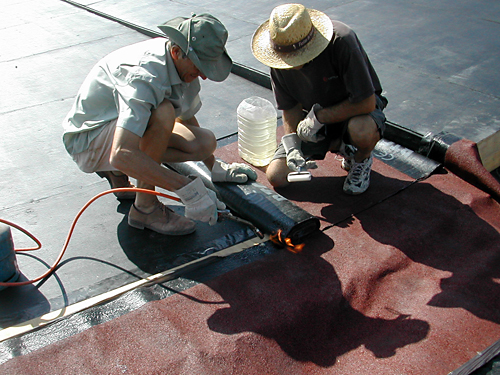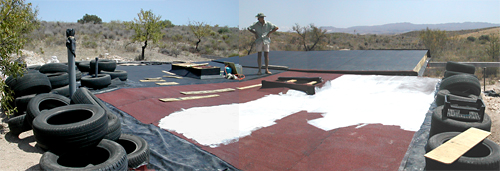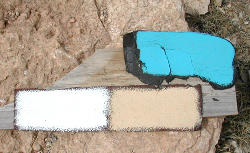
Welcome to our earthship Earthship Get Started Book Recently Asked Questions The Build Gallery Earthship in the news Diary Recipes Earthship Living Ethical Fashion Links Books Contact us  |
WaterproofingWe did the same with this stage as we did with the insulation - we went round in circles for a good long time trying to decide how to do this. The books recommend various methods of waterproofing including rigid metal roofing, bitumen and EPDM rubber roofing. The longest lasting is the metal roof, but this is rigid and squared off which wasn't what we were after as the roof can be seen from lots of places on the land. We wanted a more organic look for it. Stone chipped bitumen with coatings of acrylic paint was the next best option - and organic looking, so we decided to go for this. Then we changed our minds and started looking into a fibre glass roof! But this became complicated and potentially time-consuming and expensive. So, that brought us back to bitumen. There are various layers to the roofs which are detailed in the books, although Michael Reynolds does suggest contacting a roofing specialist local to you. We were helped by a builder friend, Clive, who has done a few bitumen roofs and has plenty of experience in building. He suggested we paint a layer of bitumen paint on the plywood before putting on the bitumen. This we sourced from a local building suppliers - Angel Oller in Albox - and was (surprisingly) water based. We watered down the first layer and put the second layer on neat. It's awful, gloopy, sticky stuff, that smells horrible and gets everywhere. Be prepared to throw buckets and rollers away after using it.
Stone chip bitumenNext came the roll bitumen, sourced from Angel Oller, which was heat sealed in place. Doing this in July was good in some ways as the heat made the bitumen very plyable and stick together well. On the down side it became so soft by lunchtime that it was tearing easily and we were sticking to it. The only way to cool down the bitumen was by painting the first coat of acrylic paint on asap. In reverse, Clive has worked with it in winter and says that it can become brittle and difficult to handle, not to mention the wind and rain. Summary, do this stage in Spring or Autumn if you can!!
Acrylic paint to make water from roof drinkableThe acrylic paint is the type used for terraces here so it's extra strong, the make we used is PINAY and is called Elastica Terrazas (bought from Su Pin Box in Albox). White was the best colour for deflecting heat. The first layer has to be watered down a fair bit, by about 30%, so it get's into all the nooks in the stones. The second layer I watered down a bit too as this made it easier to apply in the heat.
The roof with it's first layer of white paint:

|
   |





